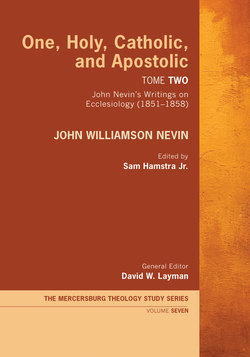Читать книгу One, Holy, Catholic, and Apostolic, Tome 2 - John Williamson Nevin - Страница 8
На сайте Литреса книга снята с продажи.
Editor’s Introduction
ОглавлениеAs noted in the general introduction to Tome 1, the “Church Question” boils down to this query: is the Church, as represented by appropriately constituted local congregations and served by properly instituted and ordained pastors, essential in the Triune God’s strategy to seek and save the lost?23 If the answer is “Yes,” as Nevin asserted, then the ministry of the local church is the normal divine instrument by which children within the church are nurtured in the faith and adults outside of the church are brought to faith. That answer to the “Church Question” naturally leads to another series of questions: How do I find this church among the religious options in my community? How do I know if a congregation is the true church and not an imposter? What are the marks of the true church?
Throughout history, Christians have answered those questions by corporately creating succinct lists of the marks of the true church. During the Reformation era, the Protestants insisted that the list include the proper preaching of the Word of God and administration of their abbreviated list of sacraments: the Lord’s Supper and baptism. More recently, John Howard Yoder and William Visser ‘t Hooft identified three essential functions of the true church: witness, service, and communion.24 Back in the fourth century, Christians included four marks of the church in the Nicene-Constantinople Creed: one, holy, catholic, and apostolic. By so doing, the church followed the example of those who had come before them. In the time period immediately following that of the apostles, the church developed baptismal creeds that included marks of the true church, such as holy and catholic. The Apostles’ Creed, the complete text of which doesn’t appear until the eighth century, grew out of these creeds. For this reason and more, Philip Schaff calls it the “Creed of creeds” and described it “as an admirable popular summary of the apostolic teaching, and in full harmony with the spirit and even the letter of the New Testament.”25
Of all the lists of the true marks of the church created throughout the history of the Christian church, John Nevin gravitated towards those of the ante-Nicene and Nicene era—in particular, one, holy, catholic, and apostolic. Throughout his extensive career, Nevin commented upon and defended each of those as they provided a positive vision for an American Protestant church ruptured by sectarianism and individualism. Of those four marks, Nevin dedicated a significant amount of energy to catholicity. In the process, he distinguished the ecclesiology of Mercersburg Theology from that of both the Roman Church and the Anglican Church, as well as from most of Protestantism, thereby earning his reputation as “Catholic and Reformed”26 or “High-Church Calvinist.”27
In his revealing and remarkable article entitled “Catholicism,” Nevin systematically and carefully unpacks the catholicity of the true church. While most Christians “generally understood” catholicity as universal, Nevin suggested an alternative, one rooted in the incarnation. Brad Littlejohn has noted, “For the Church to be ‘catholic’ means that it constitutes the proper wholeness of mankind and creation; it is no mere universal convocation of men from all over the world, but the renewal of the human race as a whole.”28 Richard Wentz adds,
Nevin here suggests that Christianity, perhaps more accurately Christ as the Incarnation, represents the introduction of wholeness into the life of the world. The world can never again escape the fact that claims to truth are particular and partial realizations of a truth that is greater than the sum of its parts. Any claim to exclusiveness is inevitably challenged by the inclusive wholeness already present in “the earth in its natural form”. . . . For Nevin Christianity was catholic in the sense that it represents the universal in our midst, already present, but judging and beckoning us to a more radical realization than is present among individuals, whether they are aware of it or not.29
For Nevin, then, catholicity is “no vague dedication to universality, even in some morally ideal sense.” Instead, “it is the discovery of wholeness amid the penultimate claims of the world, as expressed in human history.”30
23. Hamstra, general introduction to One, Holy, Catholic, and Apostolic, Tome 1, 17.
24. See Nikolajsen’s discussion on marks of the church in The Distinctive Identity of the Church, 117–18.
25. Schaff, History of the Creeds of Christendom I.2.7. The Mercersburgian writings on the Apostles’ Creed are slated to appear in volume 8 of MTSS.
26. See Yrigoyen and Bricker, Catholic and Reformed.
27. See Hart, Nevin: High–Church Calvinist and Layman, general introduction to Born of Water and the Spirit, 12–19.
28. Littlejohn, Mercersburg Theology, 149.
29. Wentz, Nevin: American Theologian, 66–67.
30. Ibid., 69.
